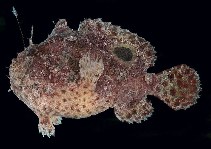| Family: |
Antennariidae (Frogfishes) |
| Max. size: |
5.8 cm SL (male/unsexed) |
| Environment: |
reef-associated; marine; depth range 0 - 130 m |
| Distribution: |
Indo-Pacific: Red Sea, Philippines, Indonesia, Marshall Islands, Gilbert Islands and Lord Howe Island. |
| Diagnosis: |
Dorsal spines (total): 3-3; Dorsal soft rays (total): 11-12; Anal spines: 0-0; Anal soft rays: 7-8. Bony part of illicium< 1.8 length of soft dorsal fin base; esca a small bulbous knot of filaments. Has a second dorsal spine not connected to the body by a web of skin and bearing numerous tiny tufts and a filamentous tip.
Description: Characterized by having an illicium almost two times the length of second dorsal spine; with about five dark spherical swellings at base of esca; third dorsal spine has curved tip (Ref. 90102). |
| Biology: |
Lives at moderate depths in sponge zones (Ref. 48635); occurs in seaward reef flats. Minimum depth reported taken from Ref. 57178. Coral and Rocky reefs in 0-130 m, more common between 30-40 m (Ref 90102). |
| IUCN Red List Status: |
Not Evaluated (N.E.) Ref. (130435)
|
| Threat to humans: |
harmless |
Source and more info: www.fishbase.org. For personal, classroom, and other internal use only. Not for publication.
